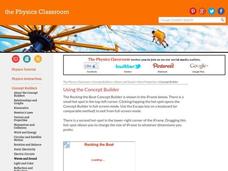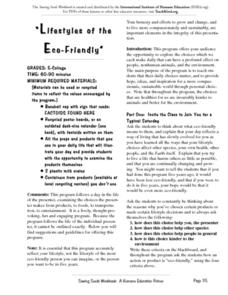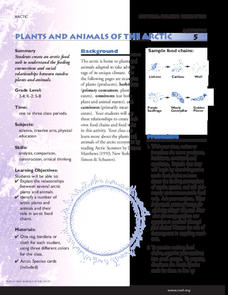US Environmental Protection Agency
Building an Model Aquifer
With almost half of Americans relying on groundwater supplies, it is more important than ever to protect aquifers from possible contaminants. Working in small groups, young environmentalists explore this problem as they create an aquifer...
Physics Classroom
Rocking the Boat
Sometimes it's okay to rock the boat! Science scholars manipulate wave properties using a fun interactive. Part of a larger playlist that dives into waves and sound, the lesson helps users work their way from apprentice to wizard by...
Curated OER
Word Search: Common Pond Mammals
Mammals who live in pond environments are the focus of this colorful wordsearch. In it, youngsters find the names of 13 mammals who are found near ponds. Each of the animals has a colorful picture associated with it. Very nice.
Curated OER
Common Pond Plants and Invertebrates
Here is a wordsearch that has learners find 18 different organisms that are commonly-found in pond environments. The monarch butterfly, cotton grass, water flea, and the damesfly are just a few of the organisms found. Colorful and...
Curated OER
Microfishing
Students use a simple method to collect living microorganisms from natural and/or artificial environments and develop skills in microscopy, observation, drawing, speculation, hypothesizing, oral presentation, and raising questions.
Curated OER
Alaska Rock Garden Project
Young environment experts examine the different types of rocks. They create their own rock garden to keep throughout the school year. Although this lesson is written for the Alaskan landscape, a rock garden can be created in almost any...
Curated OER
Water Pollution
Here is a fine lesson for fifth graders that will give them an idea of the variety of impacts that human-introduced pollutants have on the environment. After an initial class discussion and teacher-led demonstration, pupils brainstorm...
Curated OER
Words In the News Big Rise in CO2
Middle schoolers complete vocabulary and word work activities including an online quiz. They read an online article while focusing on answering specific information questions. They discuss ways to improve the environment and present them...
Curated OER
Color the Snow
Are your teaching in a cold and snowy environment? If so, then try out this fun activity with your class. You mix a variety of colors in large jars to show learners the difference between primary and secondary colors, then let them mix...
Desert Discoveries
What's the Buzz on Native Bees?
Young biologists describe the different types of bees that are native to the Sonoran Desert. They look at the nesting and feeding requirements of the insects, and study how they are able to pollinate many plants found in the environment....
Curated OER
Knowing the Essential Elements of a Habitat
First graders compare their environment with that of Belize by researching via the internet on the sites provided. Students participate in various activities/centers utilizing the information they discovered.
Curated OER
How Can Clear of Tress Destroy a Community?
Fifth graders brainstorm the relationship between trees and humans to determine how humans benefit from trees and how they benefit from us. They discuss oxygen/carbon dioxide exchange, soil stablization, animal habitat, shade, medicine...
Curated OER
Monoculture and Polyculture
Ecology explorers collect soil and invertebrates from a monoculture and a polyculture area. They relate the number and types of invertebrates to the surrounding environmental conditions. This activity can be used as an introduction to...
Curated OER
Lifestyles of the Eco-Friendly
A helpful worksheet encourages pupils to make environmentally-friendly choices at home. The packet presents many ways that learners can help the environment, such as taking shorter showers in order to conserve water.
Curated OER
Leaf-Motif Frame
Students research leaves and their life cycle as well as their importance to the environment. After discussing photosynthesis, habitats, and nutrients for the soil, students collect and identify fallen leaves. Students use their...
Curated OER
Rivers and Streams
In this rivers and streams worksheet, learners explore how rivers and streams react with the environment. Students also study where the major rivers flow in their local areas. Activities are provided that help learners visualize the...
Curated OER
My Habitat
Students explore the environment they live in. In this habitats lesson, students define habitat and create a web in kidspiration. Students take a walk outside and record what they see and hear and may take pictures as well. Students...
Curated OER
MATERIALS, Using What’s Local: Native Materials, Local Sources
Young scholars consider the development of different societies. In this environmental building instructional activity, students consider local resources and how societies choose to use them. Young scholars use their findings to design a...
Curated OER
Where Is Away?
Students explore garbage. In this landfill lesson, students investigate how much garbage is collected in landfills on average each day. Students discover hazardous materials that are disposed of improperly and the effects of these...
Curated OER
Gaming in the Outdoors
Students explore their environment through a scavenger hunt. In this outdoor exlporation lesson, students use hunt cards and search for animal food, natural shapes, or both. Students share their finds. Students create ink prints or...
Curated OER
Trail Impact Study
Students create maps through trails that keep the environment safe. in this trail plotting lesson, students mark off a trail to show hazards, erosion threshold, and slope. Students record information about their trail on a data board...
Curated OER
Food Chain
Fourth graders explore the concept of food chains. In this food chain lesson, 4th graders discuss what different animals eat and how they are all connected. Students explore a garden and the environment around them to find examples of a...
National Wildlife Federation
Habitat Hunt
Put yourselves in their shoes—or, in this case, their paws. Learners assume the role of an animal and scan a habitat looking for features to fulfill their basic needs. Based on their findings, they decide if the habitat is a suitable...
National Wildlife Federation
Plants and Animals of the Arctic
The Arctic food web may be more limited than other environments, but it has all the same components. With an interactive activity, pupils assume the roles of the components of an Arctic food chain. They move around and link themselves to...
Other popular searches
- Environment Science
- Environmental Science
- Environmental Science Games
- Environmental Science Unit
- Ap Environmental Science
- Living Environment Science
- Environmental Science Energy
- Environmental Science Maps
- Environment Science Labs
- Land Use Environment Science
- Environment Science Dilemma
- Environment Science Graphing

























